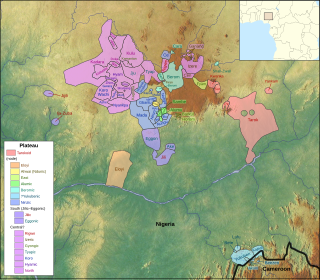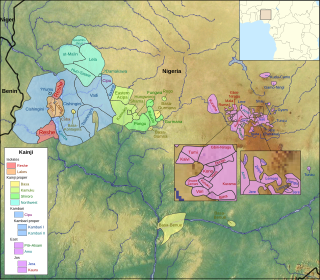
Benue–Congo is a major subdivision of the Niger–Congo language family which covers most of Sub-Saharan Africa. It consists of two main branches:

The forty or so Plateau languages are a tentative group of Benue–Congo languages spoken by 3.5 million people on the Jos Plateau and in adjacent areas in central Nigeria. The original formulation included the Jukunoid and Kainji languages, and later the Dakoid languages; Jukunoid and Kainji now form a parent branch of Plateau called Central Nigerian (Platoid).

Ngas, or Angas, is an Afro-Asiatic language spoken in Plateau State, Nigeria. Dialects are Hill Angas and Plain Angas. Retired General Yakubu Gowon is a prominent Nigerian who is of Ngas extraction.
u̠t-Ma’in or Fakai is a Northwest Kainji dialect continuum spoken by 36,000 people in the Fakai district of Nigeria. There are numerous rather divergent dialects:
The East Kainji languages are spoken in a compact area of the Jos Plateau in Nigeria, near Jos. There are more than 20 of them, most of which are poorly studied.
The Kambari languages are a cluster of Kainji languages spoken in northwestern Nigeria. They are:
Jere (Jera) is a dialect cluster of Kainji languages in Nigeria. It is named after the Zelle (Jere) dialect.
The Kamuku languages are a branch of the Kainji languages spoken in the Jos Plateau of Nigeria. They are:
Bauchi is a cluster of Kainji languages spoken in Nigeria.
Kimba is a Kainji language cluster of Nigeria spoken by the Kambari people. As of 2004, there were 100,000 native speakers.
Gwamhi-Wuri (Wurə-Gwamhyə-Mba), or Lyase, is a Kainji language of Nigeria. There are three varieties, which have only slight differences. "Lyase-Ne" means 'mother tongue'.
Lere is a nearly extinct Kainji dialect cluster of Nigeria. The ethnic population was cited as 16,000 in 2000, of whom only a few speak the language. A wordlist from the Takaya dialect can be found under External links.
Gyem is a Kainji language of Bauchi State, Nigeria.
Zora (Izora), or Cokoba (Cokobanci) in Hausa, is a Kainji language of Nigeria.
The six Northwest Kainji languages, formerly known as Lela, are spoken near Kainji Lake on the Niger River in Nigeria. They are distinguishable from other Kainji languages by the reduction of their noun-class prefixes to single consonants.
Basa is a cluster of Kainji languages scattered across Nigeria. They are spoken in distinct communities from Niger State in the northwest to Benue State in the south-centre. This means that the Basa may be the next most widespread people in Nigeria after the Hausa and Fula. Distant groups are not aware of each other, and those near their apparent homeland near the Kambari have lost their language.
Yumu is a minor Kainji language of Nigeria. It is listed as a potential Kambari language by Roger Blench, however it does not have an Ethnologue nor Glottolog entry.




